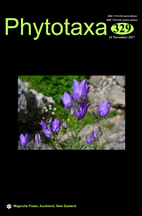Abstract
Populations of a fragilarioid diatom from inter-dune lakes of the Badain Jaran Desert (northern China), originally identified and reported under the name Fragilaria sp. cf. famelica, were investigated in detail using light and scanning electron microscopy. The analyses indicate that most of the morphological features of this taxon are identical to Williamsella angusta Graeff, Kociolek & S.R. Rushforth, the type species of the genus Williamsella recently described from Blue Lake warm spring (Utah, USA). The criteria used to separate Williamsella from Fragilaria (i.e. the presence/absence of spines, the colonial formation, the preference for saline vs freshwater habitat, and the coverings of the areolae) are not supported and the genus is refuted. Instead the new combination Fragilaria crenophila comb. nov. is proposed for the Blue Lake species. The taxon from the Badain Jaran desert lakes represents a varietal population that is characterized by shorter valve length and lower stria density than the nominal variety, and is given the name Fragilaria crenophila var. sinensis. A discussion of the taxonomy, ecology and geographical distribution of this taxon is presented and a detailed comparison with Fragilaria asiatica Hustedt, a very similar species described from northern Tibet (China) is made.

